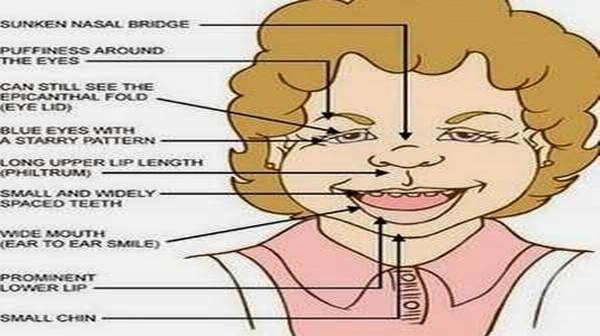Williams syndrome (WS), also known as Williams–Beuren syndrome (WBS), is a developmental disorder that affects many parts of the body. It is characterized by medical problems, including cardiovascular disease, developmental delays, and learning disabilities. These occur side by side with striking verbal abilities, highly social personalities and an affinity for music. People who have Williams syndrome are missing genetic material from chromosome 7, including the gene elastin. This gene’s protein product gives blood vessels the stretchiness and strength required to withstand a lifetime of use. The elastin protein is made only during embryonic development and childhood, when blood vessels are formed. Because they lack the elastin protein, people with Williams Syndrome have disorders of the circulatory system and heart.
Can Williams syndrome be inherited?
Most cases of Williams syndrome are not inherited, but occur as random events during the formation of reproductive cells (eggs or sperm) in a parent of an affected individual. These cases occur in people with no history of the disorder in their family.
Williams syndrome is considered an autosomal dominant condition because one copy of the altered chromosome 7 in each cell is sufficient to cause the disorder. In a small percentage of cases, people with Williams syndrome inherit the chromosomal deletion from a parent with the condition.
Causes
Williams syndrome is a rare condition caused by missing a copy of several genes. Parents may not have any family history of the condition. However, a person with Williams syndrome has a 50% chance of passing the disorder on to each of his or her children. The cause usually occurs randomly.
Williams syndrome occurs in about 1 in 8,000 births.
One of the 25 missing genes is the gene that produces elastin, a protein that allows blood vessels and other tissues in the body to stretch. It is likely that missing a copy of this gene results in the narrowing of blood vessels, stretchy skin, and flexible joints seen in this condition.
Symptoms
A syndrome is a set of symptoms that occur together. In some medical syndromes, the condition is not always apparent when an individual is born. As symptoms start to develop, your doctor can take note of them and make an appropriate diagnosis. Williams syndrome is a condition made up of specific symptoms that significantly impact health and development.
Common symptoms of the condition include:
- specific facial features like a wide mouth, small upturned nose, widely spaced teeth, and full lips
- colic or feeding problems
- attention deficit disorder
- learning disorders
- inward bend of pinky finger
- specific phobias
- short stature
- speech delays
- sunken chest
- varying degrees of mental retardation
- low birth weight and muscle tone
- kidney abnormalities
- farsightedness
Personality traits common in individuals with the condition include an interest in music, aversion to physical contact, being overly friendly, and sensitivity to loud noises.
Diagnosis
Doctors can identify the syndrome by its distinctive physical characteristics. They can confirm the diagnosis by using a special technique called FISH (fluorescent in situ hybridization).
The chromosomal deletion that causes Williams Syndrome is so small that it cannot be seen in a karyotype. The deletion can be observed, however, with FISH. This technique allows DNA sequences to be labeled with a fluorescent chemical (called a probe) that lights up when exposed to ultraviolet (UV) light. The Williams Syndrome deletion can be detected by labeling the elastin gene with a fluorescent probe. The gene will light up under a UV light only if it is present; a lack of signal indicates a deletion.
Treatment
There is no cure for Williams syndrome. Suggestions include avoidance of extra calcium and vitamin D, as well as treating high levels of blood calcium. Blood vessel narrowing can be a significant health problem, and is treated on an individual basis. Physical therapy is helpful to patients with joint stiffness and low muscle tone. Developmental and speech therapy can also help children and increase the success of their social interactions. Other treatments are based on a patient’s particular symptoms.
The American Academy of Pediatrics recommends annual cardiology evaluations for individuals with Williams syndrome. Other recommended assessments include: ophthalmologic evaluations, an examination for inguinal hernia, objective hearing assessment, blood pressure measurement, developmental and growth evaluation, orthopedic assessments on joints, muscle tone, and ongoing feeding and dietary assessments to manage constipation and urinary problems.
Behavioral treatments have been shown to be effective. In regards to social skills it may be effective to channel their nature by teaching basic skills. Some of these are the appropriate way to approach someone, how and when to socialize in settings such as school or the workplace, and warning of the signs and dangers of exploitation. For the fear that they demonstrate cognitive-behavioral approaches, such as therapy, are the recommended treatment. One of the things to be careful of with this approach is to make sure that the patients’ charming nature does not mask any underlying feelings.
Perhaps the most effective treatment for those with Williams syndrome is music. Those with Williams syndrome have shown a relative strength in regards to music, albeit only in pitch and rhythm tasks. Not only do they show a strength in the field but also a particular fondness for it. It has been shown that music may help with the internal and external anxiety that these people are more likely to be afflicted with. Something of note is that the typical person processes music in the superior temporal and middle temporal gyri. Those with Williams syndrome have a reduced activation in these areas but an increase in the right amygdala and cerebellum.
Prognosis
About 75% of those with Williams syndrome have some intellectual disability.
Most patients will not live as long as normal, due to complications.
Most patients require full-time caregivers and often live in supervised group homes.





